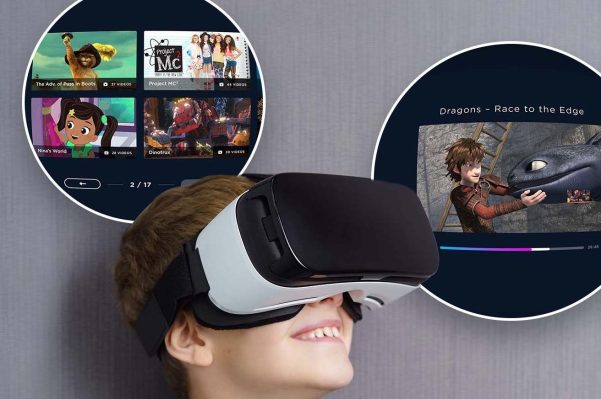If you’re diagnosed with lazy eye — otherwise known as amblyopia — as a child, there are only a few options at your disposal. You can wear an eye patch, you can take eye drops or you can wear corrective lenses. Or, in the future (pending FDA clearance), you could watch TV.
That’s the central idea behind Luminopia, a four-person startup headed by Scott Xiao and Dean Travers. Xiao and Travers started Luminopia six years ago as undergrads at Harvard University, and first heard about the condition from a classmate who had struggled with amblyopia as a child. Lazy eye is the most common childhood form of vision loss, and affects about three out of every 100 kids.
Amblyopia can develop early in life when something causes one eye to struggle to keep up with the other. There might be muscle strength imbalances between eyes, which causes one to lag behind, one eye might be far stronger than the other or one eye might be deprived of clear vision, due to a cataract or other obstacle. Over time, the brain learns to depend upon vision in one eye, while the other gets weaker, eventually, in severe cases, leading to permanent vision loss.
The common treatments for lazy eye involve eye drops, corrective lenses or eye patching — which strengthen the weaker eye. Luminopia’s solution is different; kids watch TV through a VR headset with the parameters of the show slightly altered (the company has struck deals with Sesame Workshop, Nickelodeon, DreamWorks and NBC to provide over 100 hours of content). Contrast might be dialed up or dialed down, or parts of each image might be removed to encourage the weaker eye to keep up with the stronger one.
“We’re actually altering the image parameters in real time, with the goal of promoting weaker eye usage and encouraging patients’ brains to combine input from both eyes,” says Xiao.
In September, the company published results of a randomized controlled trial on 105 kids. All the kids wore glasses full-time, but 51 of them also watched one hour of TV shows modified by Luminopia’s software six days per week for 12 weeks.
Overall, the kids in the treatment group improved their sight by 1.8 lines on a standard eye chart, compared to .8 lines in the comparison group (though some kids saw improvements of two or more lines at the 12-week follow-up visit).
The study was published in “Ophthalmology.”
Luminopia is still a small enterprise — there are just four employees. But the company has raised about $12 million so far with investment from Sesame Ventures (the Sesame Workshop venture capital arm), and angel investors like Robert Langer, a co-founder of Moderna (now Luminopia’s board director), and Jeffrey Dunn, the former president and CEO of Sesame Workshop.
The company has distinguished itself by its unique approach to a common problem in amblyopia, and in healthcare in general: adherence to treatment.
There’s some evidence that lazy eye treatments are hard to stick with. One study conducted in a hospital in Saudi Arabia surveyed 37 families with children who were using eye patches to treat amblyopia. The kids in the study only completed about 66% of the prescribed patching time. Families cited social stigma, discomfort and flat out refusal to wear the patch as some common reasons why they struggled to keep up with eye patching recommendations.
One 2013 study in “Investigative Ophthalmology & Visual Science” analyzed how well 152 kids complied with eye patch treatments, and found that on about 42% of days, kids skip patching altogether.
Luminopia’s founders created their treatment for lazy eye by approaching the adherence problem first — a strategy borrowed from the consumer product world.
“We’ve always seen such a huge gap in the experience of things in the consumer world, where things are so thoughtful and so delightful, and healthcare where so often we see poor experiences that lead to low adherence,” says Travers.
As for kids, there aren’t much more appealing things to do than watching TV, Xiao notes. And the trial appears to prove that thesis: The kids in the study completed 88% of the minutes of TV watching required of them. And 94% of parents said they were likely or very likely to use the treatment over an eye patch.
The key, though, is to have the data and FDA approval to prove that these “delightful” treatment experiences actually work and overcome the adherence problem. Luminopia’s most recently published trial follows a single-arm pilot trial, which evaluated the technology’s at nine sites, and on a total of 84 participants. In the first phase of that pilot trial, conducted on 10 kids, the team found that children completed 78% of the prescribed minutes of treatment. They also saw improvements in their vision that equated to about three lines on a standard eye chart. Those results were published in “Scientific Reports.”
Luminopia isn’t the first company to start evaluating game- or, for lack of a better word, fun-based treatments for diseases. The FDA has already been somewhat in support of other proposals in this vein.
Another company, Akili Interactive, gained FDA approval in June 2020 through the De Novo pathway for a video game used to treat ADHD in kids. That approval marked the first time the agency had approved a video game to treat a disease. In total, Akili Interactive has garnered about $301.1 million in funding, per Crunchbase.
Akili’s game, called EndeavorRx, does show a pathway to approval that Luminopia might be able to mimic. Luminopia, like EndeavorRx, is a prescription-only therapeutic service that doesn’t have a predecessor. Luminopia, says Xiao, will also follow the De Novo pathway as it seeks FDA approval this year. The data from its most recent pivotal trial was submitted to the FDA last March.
“We are anticipating a decision by the end of the year, and provided it’s a positive decision, we’re looking to launch the product early this year,” he says.
Credit: Source link


Comments are closed.